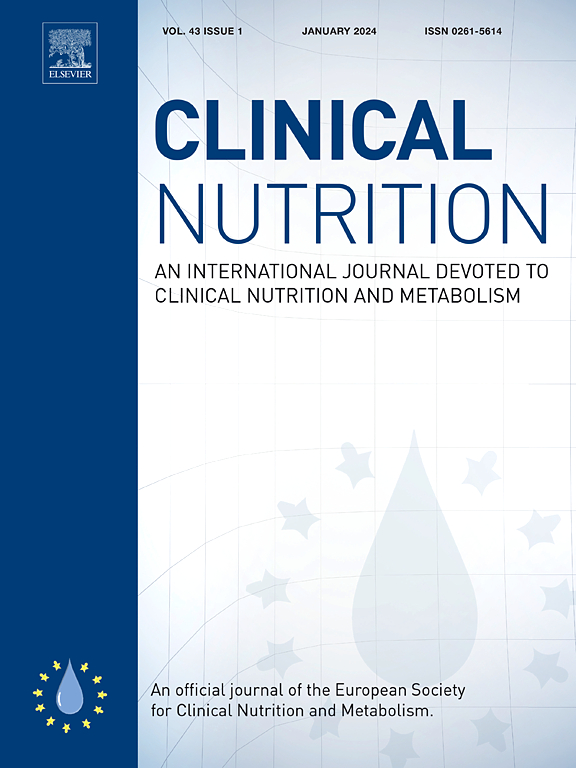老年人血清带蛋白水平与肌肉减少症之间的关系:肠通透性如何影响肌肉减少症?
IF 7.4
2区 医学
Q1 NUTRITION & DIETETICS
引用次数: 0
摘要
背景,目的肌肉减少症以肌肉质量和功能的逐渐丧失为特征,显著降低老年人的生活质量并增加死亡风险。最近的证据强调了肠通透性及其相关生物标志物zonulin在慢性炎症途径中肌肉减少症的发展中的作用。然而,血清带蛋白水平与肌肉减少症之间的关系尚不清楚。本研究旨在探讨血清带蛋白水平与老年人骨骼肌减少症之间的关系,并评估带蛋白作为骨骼肌减少症诊断生物标志物的潜力。方法前瞻性纳入93例年龄≥60岁的患者。采用酶联免疫吸附试验(ELISA)测定血清带蛋白水平,采用国际物理与康复医学学会(ISPRM)、肌肉减少症特别兴趣小组(ISarcoPRM)专家算法建立肌肉减少症诊断,包括握力、椅架测试(CST)和经体重指数(BMI)调整的大腿前肌厚度的超声测量。采用Logistic回归和受试者工作特征(ROC)曲线分析来评估肌肉减少症的预测因素和zonulin的诊断效果。结果肌少症患者zonulin水平明显高于非肌少症患者(24.92 ng/ml [21.01-27.06] vs. 19.52 ng/ml [18.00-22.85];p & lt;0.001)。多因素logistic回归鉴定出zonulin(优势比(OR) = 1.204, 95%可信区间(CI): 1.043 ~ 1.391;P = 0.011)作为肌肉减少症的独立预测因子。ROC分析显示曲线下面积(AUC)为0.745,zonulin的最佳截止值为23.33 ng/ml(71%的敏感性,79%的特异性)。结论血清zonulin水平升高与老年人骨骼肌减少症相关,提示肠屏障功能障碍在骨骼肌减少症病理生理中的潜在作用。Zonulin有望作为一种新的肌肉减少症诊断生物标志物,需要进一步的纵向研究来阐明因果关系和临床应用。本文章由计算机程序翻译,如有差异,请以英文原文为准。
The association between serum zonulin levels and sarcopenia in older adults: How does intestinal permeability affect sarcopenia?
Background & aims
Sarcopenia, characterized by the progressive loss of muscle mass and function, significantly reduces the quality of life and increases mortality risk in older individuals. Recent evidence highlights the role of intestinal permeability and its associated biomarker, zonulin, in the development of sarcopenia via chronic inflammation pathways. However, the relationship between serum zonulin levels and sarcopenia remains unclear. This study aims to investigate the association between serum zonulin levels and sarcopenia in elderly individuals and to assess the potential of zonulin as a diagnostic biomarker for sarcopenia.
Methods
A total of 93 patients aged ≥60 years were prospectively included. Serum zonulin levels were measured using enzyme-linked immunosorbent assay (ELISA), and sarcopenia diagnosis was established using the International Society of Physical and Rehabilitation Medicine (ISPRM), experts in the special interest group on sarcopenia (ISarcoPRM) algorithm, incorporating handgrip strength, chair stand test (CST), and ultrasonographic measurements of anterior thigh muscle thickness adjusted for body mass index (BMI). Logistic regression and Receiver Operating Characteristic (ROC) curve analyses were conducted to evaluate predictors of sarcopenia and zonulin's diagnostic performance.
Results
Zonulin levels were significantly elevated in sarcopenic patients compared to non-sarcopenic counterparts (24.92 ng/ml [21.01–27.06] vs. 19.52 ng/ml [18.00–22.85]; p < 0.001). Multivariate logistic regression identified zonulin (odds ratio (OR) = 1.204, 95 % confidence interval (CI): 1.043–1.391; p = 0.011) as an independent predictor of sarcopenia. ROC analysis revealed an area under the curve (AUC) of 0.745, with an optimal zonulin cutoff of 23.33 ng/ml (71 % sensitivity, 79 % specificity).
Conclusions
Elevated serum zonulin levels are associated with sarcopenia in elderly individuals, suggesting a potential role of intestinal barrier dysfunction in sarcopenia pathophysiology. Zonulin shows promise as a novel biomarker for sarcopenia diagnosis, warranting further investigation in longitudinal studies to clarify causality and clinical utility.
求助全文
通过发布文献求助,成功后即可免费获取论文全文。
去求助
来源期刊

Clinical nutrition
医学-营养学
CiteScore
14.10
自引率
6.30%
发文量
356
审稿时长
28 days
期刊介绍:
Clinical Nutrition, the official journal of ESPEN, The European Society for Clinical Nutrition and Metabolism, is an international journal providing essential scientific information on nutritional and metabolic care and the relationship between nutrition and disease both in the setting of basic science and clinical practice. Published bi-monthly, each issue combines original articles and reviews providing an invaluable reference for any specialist concerned with these fields.
 求助内容:
求助内容: 应助结果提醒方式:
应助结果提醒方式:


